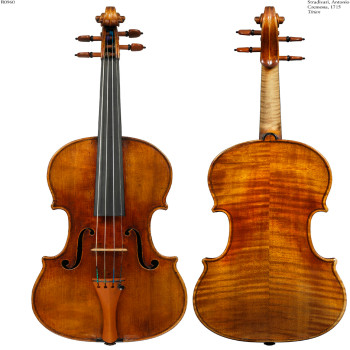Margaret Batjer is an accomplished violin player who tours the world, a concertmaster with The Los Angeles Chamber Orchestra, and a professor of Classical Performance and Composition at USC – so let’s just say she’s very qualified to tell us what makes a good violin. Specifically, what makes the iconic Stradivarius violin she occasionally plays — the storied “Milstein Strad” — eight million dollars good.
Margaret curated “Strad Fest LA” — a series of concerts that begin this week, in which musicians will showcase eight of Antonio Stradivari’s best known, most significant violins, each with an average of 303 years of musical history to its name – and, yes, each one has a name.
You can also hear this bonus clip of Ms. Batjer playing the Milstein Strad in our studio.

Rico Gagliano: And now, it’s time for Chattering Class, the part of the show where we are schooled by an expert in some party-worthy topic, and today, our subjects are the celebrated Stradivarius violins, and our teacher is Margaret Batjer.
She plays solo violin in concert halls around the world and is a concert master with the Los Angeles Chamber Orchestra. She also curated the orchestra’s “Strad Fest LA,” which kicks off Wednesday. That is a series of performances in which musicians will be playing eight Strads worth $40 million dollars. Margaret, welcome to you, and to the Strad you brought with you.
Margaret Batjer: Thank you. We’re happy to be here.
Rico Gagliano: Thanks. You speak on its behalf.
Margaret Batjer: I do.
Rico Gagliano: So, let’s start at the beginning. The violins are crafted starting in the late 1600s by a guy named Antionio Stradivari. Tell us a little bit about the man.
Margaret Batjer: Well, Stradivari lived a very long life. He was from Cremona, Italy, which is where the center of violin-making happened in the mid-1600s, but he really came into his prime at the turn of the century, and that’s when these golden-period Strads–which we’re really highlighting at the Strad Fest–started being made. They are the most sought-after and also the most rare.
Rico Gagliano: Now, he also made harps, I believe —
Margaret Batjer: He made guitars, harps, violas, cellos…
Rico Gagliano: Why did the violins, specifically, rise to prominence? What makes them so special?
Margaret Batjer:
He made over a thousand instruments, and 650 instruments still survive today, and of those, 500 are violins. So, clearly, he did make more violins.The cellos are also extremely valuable, and very rare.
Rico Gagliano: Let’s just talk about the violins, then. What about them makes them the best violins?
Margaret Batjer: I think, probably, a combination of a lot of different things. I find the instruments to be… they have incredible boldness and finesse and elegance.
Rico Gagliano: What do you mean by ‘boldness’? In terms of volume?
Margaret Batjer: In terms of being able to reach the last row of the concert hall. They have an incredible presence in their sound, but that’s also coupled with an incredible elegance of sound.
Rico Gagliano: And, what do you mean by ‘elegance’?
Margaret Batjer: Well, Stradivariuses are — as opposed to, say, Guarneri del Gesùs, which were the other kind of comparable instrument makers in that time, and they’re both extremely valuable instruments — I’ve always said that the Guarneri del Gesù sound is like chocolate, and the Stradivarius sound is like diamonds. The del Gesùs tend to have a very, very strong bass, lots of power and push in the sound. Strads just kind of sit up there and sound lovely and beautiful.
Rico Gagliano: Kind of clearer, maybe.
Margaret Batjer: Yeah, perhaps. Perhaps.
Rico Gagliano: Do we know, technologically, why his violins have that sound?
Margaret Batjer: Certainly, Strad was an adventurer. He started messing around with his patterns around the turn of the century. But why is it that we can examine these great instruments and yet not reproduce them? There has to be something mysterious about that time, in that place.
Rico Gagliano: Are you making a case for magic?
Margaret Batjer: You know what? I’ve always said, I always do believe that that moment in history, in northern Italy… perhaps the climate, how the wood was cured… you know, they hang them up in the windows, they still do today, you see violin makers all over Cremona. The ecosystem at that time may have been just perfect for making instruments. I don’t know.
Rico Gagliano: Wow, something in the air, literally.
Margaret Batjer:
Something in the air, something in the climate, something in the moisture. The way that the sun was, maybe, without pollution, at that time, created a certain kind of magical moment. That, coupled with the extraordinary craftsmanship.
Rico Gagliano: Now, each one of these violins is given a name. It has a name and a kind of provenance. Who decides what these things are called?
Margaret Batjer: That’s a mystery, because they keep getting renamed. For example, the instrument I brought today is the Milstein Strad. Nathan Milstein was a really extraordinary violinist who died in 1992, and when he died–he played this violin for forty years of his career–therefore, it became “the Milstein Strad.” Because he was such a prominent soloist.
Rico Gagliano: And, you actually helped the owners of this Strad decide to buy it. Is that right?
Margaret Batjer: Yeah. They had asked Martin Chalifour and I — the concertmaster of the LA Philharmonic, and I — to come into Disney Hall and play nine or ten Strads that they were considering buying. So, they were brought from all over the world.
Rico Gagliano: And this one won?
Margaret Batjer: And this one won. He called it ‘the shootout at Disney Hall’.
When this one came out of the case, I recognized it immediately, because I had seen Milstein play as a young girl. I was shocked, honestly, that it was for sale, because it had been in a bank vault for thirteen years. So, I grabbed it and I was like, “Me first! I want to play!”
Rico Gagliano: But, does that color it a little bit, for you? I mean, the provenance of it is as exciting as maybe the sound it’s making.
Margaret Batjer: Absolutely!
Rico Gagliano: How do you clear that out of your head, as a musician?
Margaret Batjer: Well, you don’t! I think that’s part of the inspiration of playing the instrument; its past. And this instrument specifically, the Milstein, when I picked it up, I heard his sound. I do think instruments take on the kinds of personalities of the players.
Rico Gagliano: Can you describe how playing that instrument is different than your usual violin?
Margaret Batjer: You know, I’m blessed, because I actually have a really interesting violin. I have a Strad composite. Stradivarius’ teacher was Nicolò Amati. He made the violin. It was apparently brought into Stradivarius’ shop, and Stradivarius put a new top on the violin.
Rico Gagliano: Wow, so it’s part-Strad.
Margaret Batjer: And re-varnished. So, I have a wonderful instrument.
Rico Gagliano: Yeah. It’s kind of like taking a Lexus and putting, I don’t know, a Rolls-Royce on top of it.
Margaret Batjer: A Rolls-Royce, exactly.
Rico Gagliano: Those are both still pretty cool. But, after the 100% Strad, how tough is it to step back to your merely excellent violin?
Margaret Batjer: The first few days are a little sad. But I always know I’ll get another chance.
Rico Gagliano: All right. I should also point out that there was another, very famous violin-making family called the Gagliano violins.
Margaret Batjer: I used to own a Gagliano.
Rico Gagliano: Used to? Did you get rid of it?
Margaret Batjer: Are you related?
Rico Gagliano: I don’t know, but I’m pretty sure that they’re the best violins ever made.
Margaret Batjer: I think Stradivarius would have something to say about that.
Rico Gagliano: Well, he’s not with us anymore and I’m sitting right here, so I’m wondering when is there going to be a Gagliano Fest?
Margaret Batjer: There were a lot of Gaglianos, actually. That was like generations of violin-makers.
Rico Gagliano: So, you’re saying they’re less-rare and not cool.
Margaret Batjer: No, they’re excellent violins.
Rico Gagliano: Thank you.
Margaret Batjer: You should be proud.


